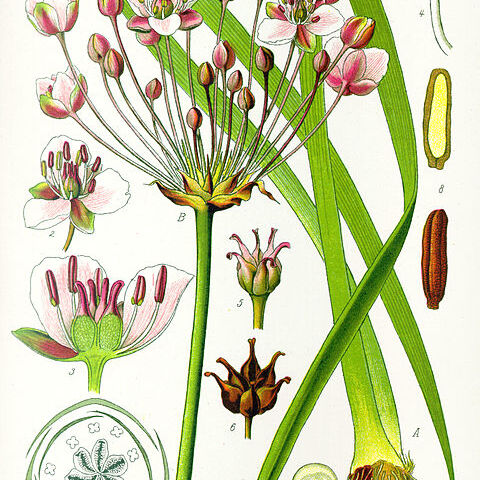Herbs, perennial, aquatic or of swamps, rhizomatous, usually with milky juice. Leaves usually emersed, basal, alternate, linear to orbicular, sheathing at base, sessile, triquetrous. Flowers hermaphroditic, in terminal, long pedunculate umbels within erect scapes, long pedicellate, with 3 free bracts. Perianth segments in 2 series, outer 3 usually sepal-like, inner 3 petal-like and usually thin and deciduous. Stamens 9, free; anthers basifixed, 2-celled, opening by longitudinal slits. Carpels 6, connate at base; ovules numerous. Fruit a whorl of follicles; follicles with apical long beak. Seeds numerous, without endosperm; embryo straight.
Herbs, perennial, rhizomatous, stemless, glabrous; sap clear. Roots not septate. Leaves basal, emersed or rarely submersed, sessile, sheathing somewhat proximally; blade with lade: translucent markings absent, basal lobes absent; venation parallel. Inflorescences scapose umbels, erect, bracteate. Flowers bisexual, hypogynous, pedicellate; tepals persistent, 6, in 2 series, scarious; stamens 9, distinct; anthers 4-loculed, dehiscing longitudinally; pistils 6, coherent proximally, 1-loculed; placentation laminar; ovules 50. Fruits follicles. Seeds: embryo straight; endosperm absent in mature seed.
Perianth 2-seriate, the outer 3 usually sepal-like, imbricate, the inner 3 petal-like and usually thin and deciduous
Carpels free; ovules numerous, scattered, on the reticulately branched parietal placentas
Stamens hypogynous, 8-9 or numerous; anthers basifixed, opening laterally
Perennial, aquatic or swamp rhizomatous herbs, usually with milky juice
Fruits opening by the adaxial suture
Seeds numerous, without endosperm
Flowers solitary or umbellate
Leaves ensiform to orbicular

